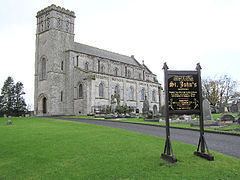Population 1,369 (2001 Census) Sovereign state United Kingdom Local time Thursday 6:53 AM District Mid-Ulster District | Irish grid reference H8583 Post town MAGHERAFELT Province Ulster Dialling code 028 | |
 | ||
Weather 9°C, Wind SW at 19 km/h, 92% Humidity | ||
Fancy a day at the jungle in moneymore northern ireland
Moneymore (from Irish: Muine Mór, meaning "large thicket or large hill") is a village and townland in Northern Ireland. It had a population of 1,369 in the 2001 Census. It is situated within Mid-Ulster District. It is an example of a plantation village in Mid-Ulster. It was the first town in Ulster to have piped water.
Contents
- Fancy a day at the jungle in moneymore northern ireland
- Map of Moneymore Magherafelt UK
- Usx moneymore 2007 the sash my father wore
- Geography
- History
- People
- Places of interest
- Transport
- Amenities
- Sport
- Schools
- Churches
- 2001 Census
- Trivia
- References
Map of Moneymore, Magherafelt, UK
Usx moneymore 2007 the sash my father wore
Geography
Moneymore lies in a glen. The Ballymully River flows through the southern part of the village. The river rises on a large hill, Slieve Gallion (one of the Sperrins), which has a radio tower on top. The village is about 35 miles from the sea to the north.
History
There was an important battle fought near Moneymore called the battle of Móin Daire Lothair in the year 563 between the Northern Uí Néill and the Cruithin tribe which the Northern Uí Néill won. This battle is recorded in the Annals of Ulster and would have been a major event at the time. Much of Great Britain and Ireland would have descent from these two groups as there was notable mixing with Scotland over the years and the Uí Néill split to form the Southern Uí Néill in the Irish midlands around this time.
Originally built by the Worshipful Company of Drapers, the village was held in such esteem that they invested in a large scale reconstruction during 1817. During The Troubles, seven people were killed in or near Moneymore in violence related to the conflict, six of them by the Provisional IRA and one by the UDA.
People
Places of interest
The most notable building in the town is the 17th century Plantation house, Springhill, built and owned by the Conyngham, later Lenox-Conyngham family but since 1957 in the ownership of the National Trust.
Moneymore Model Village depicts life in rural Ulster at the time of the Plantation.
Transport
Amenities
Moneymore has a surgery which serves villages such as the Loup, Ballyronan and Desertmartin. As well as that, Moneymore has Dalriada Emergency Surgery which is 24/7. It also has a post office, pharmacy, a number of convenience stores, a privately owned bus service, a privately owned crane company, and a privately owned bicycle shop. Until July 2006 there was a Police Service of Northern Ireland (PSNI) station.
Sport
Schools
There are two primary schools in Moneymore: Moneymore Primary School (the state primary school) and St. Patrick's Primary School (a Roman Catholic primary school). Most children of secondary school age attend one of the schools in nearby Cookstown or Magherafelt.
Churches
2001 Census
Moneymore is classified as a village by the NI Statistics and Research Agency (NISRA) (i.e. with population between 1,000 and 2,250 people). On Census day (29 April 2001) there were 1,369 people living in Moneymore. Of these:
For more details see: NI Neighbourhood Information Service
Trivia
55 Rockview Park, a terraced house in Moneymore, was reportedly haunted. [1]
On Friday 15 February 2008 at 11.00pm a Second World War bombshell was found in the Millrace Manor estate. A number of houses were evacuated and the Mace convenience store was shut for a period of time. The police were called in and the mortar bomb was found incapable of exploding.
The small New Zealand settlement of Moneymore, close to the town of Milton, was named after the Irish village (its first settlers were from the Irish Moneymore).
